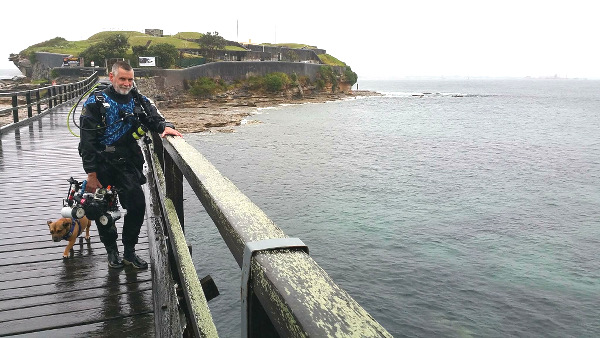
Me at Bare Island on the day the super storm started. (Photo taken by Sheree Papuni).
2016 was a fantastic year of diving. All my diving was done in Sydney at familiar dive sites other than a weekend trip to Port Stephens. This didn't mean a boring year of diving and I saw some incredible organisms around Sydney. The only dampener for the year was the massive storm that hit Sydney in June and its after effects are still being felt.
I'll cover the boring statistics first and then I can concentrate on the fun stuff. In 2016 I did a total of 143 dives which is 31 fewer dives than 2015 but 44 more than 2014 and 1 more than in 2013 - my third highest year. Considering that I didn't do any dive trips as such, that's a pretty good tally. Starting a new job in February reduced the number of days I could but I still got out as often as I could.
My average dive time was just over 91 minutes. This was more than the averages for 2015 (~80 minutes), 2014 (~70) and 2013 (73). My longest dive was 120 minutes which was a day dive at Bare Island. My shortest dive was only 30 minutes at Martin Islet because conditions were poor. My longest dive at The Leap was 116 minutes where I now dive with a 5L pony for both redundancy and extra bottom time. Cold is still my biggest problem with long dives and even with my new 7mm semidry suit I get cold if the water temperature is below 18°C. Wearing a drysuit throughout Winter certainly helps a lot.
I spent 217 hours underwater. That's equivalent to just over 9 days. It's less than last year but still a good effort.
I dived every single weekend of 2016. Some weekends I only got the one dive in but others I dived as many as 4 times. There were some weekends where the conditions were very poor and the dives were not all that enjoyable but most dives were good. I have actually dived every weekend since April 2013 and want to see how long I can keep the run going. I find it good incentive to dive every weekend, not that I really need the incentive. An extra challenge in 2016 was a minor leg operation in July. I couldn't get the wound wet for 4 weeks so the drysuit really helped.
The Leap remains my favourite dive site as can be seen from the table below. There is so much to see, including weedy seadragons and pygmy pipehorses. There were some bonuses in 2016 which added to The Leap's appeal. Bare Island is a close second, probably due to the ease of diving there, the abundance of pygmy pipehorses and that there are so many different dives that can be done there (e.g. Deep Wall, Isolated Reef, etc.). The Steps, it was almost as good a dive site as The Leap as I can usually see pygmy pipehorses and weedy seadragons but the dive can be shorter.
My interest in Shiprock has waned completely. Clifton Gardens is now my go to site if conditions elsewhere are rough. There is always something good to see there and it is an easy dive.
I did a few night dives in 2016 mostly due to being rostered on to work both days on a number of weekends. A night dive at Camp Cove, which is only 30 minutes from the Museum, is a great way to get my weekend dive in. I also did one night dive at Bare Island just before I started working.
|
|
2016 |
2015 |
2014 |
2013 |
2012 |
2011 |
|
The Leap, Kurnell, NSW, Australia |
55 |
61 |
51 |
30 |
19 |
4 |
|
The Steps, Kurnell, NSW, Australia |
31 |
23 |
15 |
21 |
5 |
5 |
|
Bare Island, La Perouse, NSW, Australia |
30 |
59 |
19 |
16 |
13 |
5 |
|
The Monument, Kurnell, NSW, Australia |
8 |
4 |
6 |
21 |
4 |
5 |
|
Camp Cove, Watsons Bay, NSW, Australia |
7 |
2 |
1 |
9 |
6 |
6 |
|
Chowder Bay, Clifton Gardens, NSW, Australia |
7 |
1 |
|
5 |
2 |
1 |
|
Fly Point, Nelson Bay, NSW, Australia |
1 |
|
2 |
|
1 |
|
|
Seahorse Gardens, Nelson Bay, NSW, Australia |
1 |
|
2 |
|
|
|
|
Martin Islet, Port Kembla, NSW, Australia |
1 |
|
1 |
|
|
|
|
Pipeline, Nelson Bay, NSW, Australia |
1 |
|
|
|
|
|
|
Halifax Point, Nelson Bay, NSW, Australia |
1 |
|
|
|
|
|
|
Gorgeous Reef, Henry Head, NSW, Australia |
|
5 |
|
11 |
1 |
|
|
Shiprock, Port Hacking, NSW, Australia |
|
4 |
6 |
9 |
18 |
14 |
|
Minmi Trench, Cape Banks, NSW, Australia |
|
2 |
|
|
|
|
|
Magic Point, Maroubra, NSW, Australia |
|
1 |
|
3 |
1 |
|
|
South Leap, Kurnell, NSW, Australia |
|
1 |
|
1 |
|
|
|
SS Hilda, Kurnell, NSW, Australia |
|
1 |
|
|
|
|
|
Silver Beach Baths, Kurnell, NSW, Australia |
|
|
3 |
2 |
|
|
|
Fish Rock Cave, South West Rocks, NSW, Australia |
|
|
2 |
|
|
|
|
Fish Rock, South West Rocks, NSW, Australia |
|
|
2 |
|
|
|
|
Thailand |
|
10 |
|
|
|
|
|
Bali |
|
|
19 |
|
|
|
|
Raja Ampat |
|
|
|
31 |
|
|
|
Komodo |
|
|
|
|
32 |
|
|
Borneo |
|
|
|
|
|
22 |
|
Vanuatu |
|
|
|
|
|
16 |
|
Other |
|
|
1 |
14 |
18 |
18 |
|
Total |
143 |
174 |
130 |
173 |
120 |
96 |
I took over 19,000 underwater photographs in 2016. Note that this is photographs taken and not necessarily good photos. This compares to over 15,500 in 2015, just over 8,000 in 2014 and just over 13,000 in 2013. Over 11,000 of the photographs in 2016 were of syngnathids: 4,128 of pygmy pipehorses, 3,777 of weedy seadragons and 2,393 of pot-bellied seahorses. It is easy to see which organisms interest me.
A review of 2016 would not be complete without a discussion of the super storm that hit Sydney and New South Wales in early June. The storm was caused by an intense low pressure system off the New South Wales coast. It was effectively a subtropical cyclone and it brought very strong winds and torrential rain.
The storm started on Saturday 4 June with light rain, strong winds and a huge swell. Ironically, it fined up on the Saturday afternoon. By Sunday it was in full swing with widespread flooding in Sydney and across the state. Huge seas pounded the coast and there was much damage. The rain was so heavy that the roof of the Australian Museum was leaking and I was called in to help clean up. Just getting to the Museum was a challenge as the Western Distributor was flooded on either side of the ANZAC bridge. The bad weather lasted a few more days but it was not as intense as it had been on the Sunday.
Interestingly, I dived at Bare Island on the Saturday morning the storm started. There was a 3-5 metre northeasterly swell but Bare Island was completely protected. The water around the island and in Congwong Bay as far as Henry Head was like a lake. You could see a line from Henry Head across to Kurnell and south of that line was like a washing machine. Kurnell was being smashed. The dive itself was brilliant with visibility at least 5 metres and almost no surge. I was able to test out my newly acquired dry suit.

Me at Bare Island on the day the super storm started. (Photo taken by Sheree Papuni).
I waited until the following Saturday before I dived again. I was keen to see the impact on Kurnell and especially the seahorses. The sea conditions were fine for a dive but I knew that the storm would have left things very messy.
Even before I hit the water at The Steps I started to see the impact of the storm. The railing down to the platform had been ripped out. A large boulder had been move 5 metres. All the grass down to the platform had been ripped out.

The boulder at The Steps that had been moved.
Under the water I was hit at first by very poor visibility. It was less than a metre which I guess wasn't too unexpected considering the storm. As I made my way towards The Leap I started to see some of the devastation from the storm. While some rocks looked untouched, others were either buried by sand or previously buried rocks were now exposed. Navigation was almost impossible due to the poor visibility and the changed terrain. I actually missed Diversity Rock completely and ended up at Big Rock before I realised. I then missed it again on my way back.
Eventually I found Diversity Rock and was saddened to not find a single seahorse. I'd seen all four the week before the storm. I was surprised to find a pygmy pipehorse on Diversity Rock and it was one I'd seen before the storm. He must have really held on tightly.
I tried to find Di's Rock and the other two seahorses but the visibility was just to poor. I was surprised, though, to see a blue-lined octopus float past me on the sand line.
After the dive I checked out The Leap. The impact of the storm was even greater there. The railings on the steps down had been all bent out of shape. Steps had been washed away on the bottom flight. A large boulder had fallen down part way down blocking the path. All of these were minor compared to the huge boulder that had been washed 50 metres down the shore line.
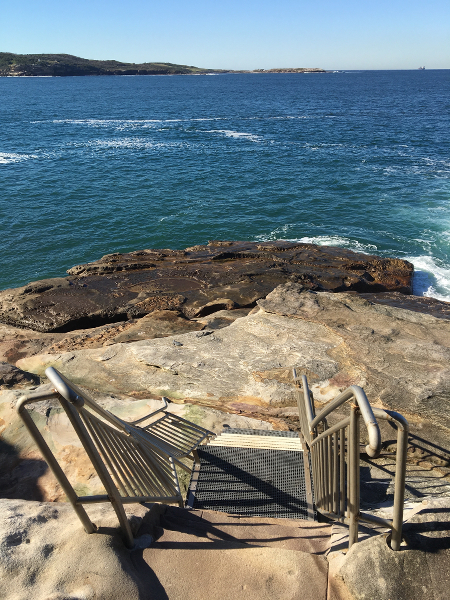
The bent railings at The Leap.
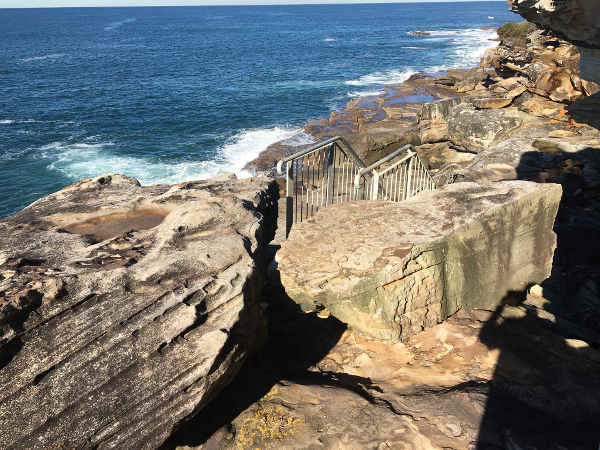
The rock blocking the path down to The Leap.
Subsequent dives, with better visibility showed me the full impact of the storm. Like I'd seen on my first dive there were some rocks left intact while others had sponges ripped out. More rocks uncovered or covered by sand. The basket star was gone; its sponge ripped in two. I believe I've found where it is now.
I will discuss the impact of the storm on the animals further below.
My only dive trip in 2016 was a weekend in Port Stephens. This was four dives: Seahorse Gardens, Fly Point, Halifax and Pipeline. It was an enjoyable weekend and I finally got to dive Pipeline.
Pipeline and Halifax Point, Port Stephens were the only new dive sites I visited in 2016. I'm not sure why I haven't dived at Pipeline before but I plan to dive there any chance I get. It was an easy dive and there were lots of animals to see, including a blue-line octopus and thorny cowfish. Halifax Point was interesting but I probably won't dive there again.
Even though I have been diving since 1978, I still managed to see a number of species for the first time in 2016. Interestingly, all but one of these were in Sydney.
I have seen giant snake eels, Ophisurus serpens, before but I was surprised to see a halfband snake eel, Malvoliophis pinguis, at Camp Cove in August. They are not often seen in Sydney.
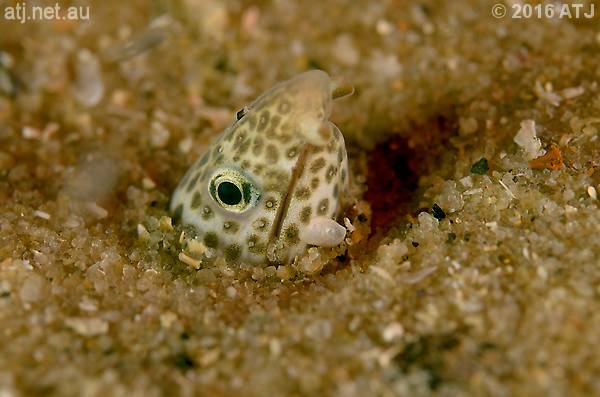
Halfband snake eel, Malvoliophis pinguis, at Camp Cove.
Another new species sighting in 2016 was a beaked salmon, Gonorynchus greyi, which I saw on the same dive at Camp Cove as the halfband snake eel above.

Beaked salmon, Gonorynchus greyi, at Camp Cove.
I saw my first freckled anglerfish, Antennatus coccineus, at Clifton Gardens on 28 March. In fact, I saw two of them. Apparently they have been seen in Sydney before but this was my first time.
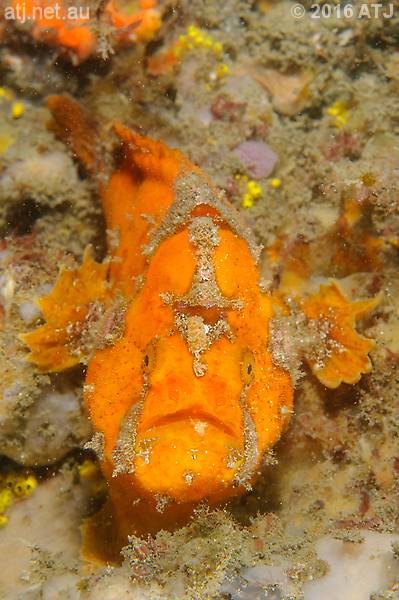
Freckled anglerfish, Antennatus coccineus, at Clifton Gardens.
My biggest first sighting was female great seahorse, Hippocampus kellogii, that turned up at Bare Island at the end of July. I first saw her on 9 August and I immediately knew she was different from pot-bellied and White's seahorses. After discussions with a few experts we determined she was a great seahorse, the first recorded sighting in Sydney. The same species has been recorded from southern Queensland and a couple of individuals at South West Rocks and Port Stephens. They were originally described from Japan but a recent paper has their distribution throughout the Indo-Pacific region. A male was sited in early November and I got to see him on 14 November. The were reports of a second male but no-one saw two together and it may have been the same male.
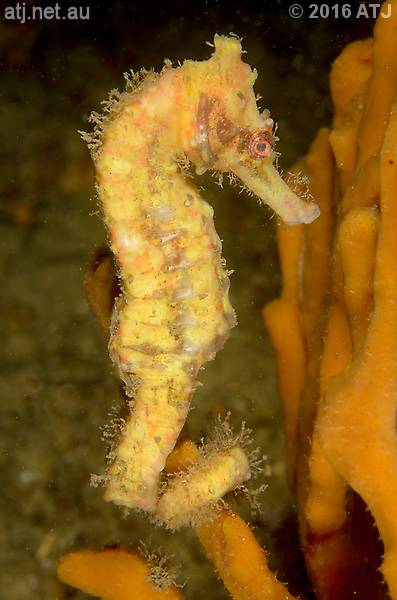
Female great seahorse, Hippocampus kelloggi.
At Fly Point, Port Stephens in April I saw a yellow-tailed angelfish, Centropyge flavicauda. This was a species I always wanted to find back when I was collecting my own aquarium fish but I was still stoked to finally see one in the wild.
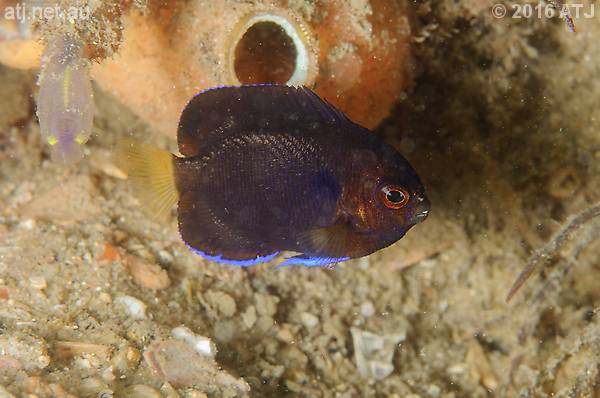
Yellow-tailed angelfish, Centropyge flavicauda, at Fly Point, Port Stephens.
In March, Peter Lightowler posted a video of a very odd looking fish he'd seen at The Leap asking for help in identifying it. It was nothing I had seen before and I couldn't even guess the family let alone the species. Mark McGrouther from the Australian Museum came to the rescue and identified it as a bearded leatherjacket, Anacanthus barbatus. We get a lot of different species of leatherjackets in Sydney but this was so different. A few days later I was diving The Leap when I saw the bearded leatherjacket, too. It was even more bizarre in person.
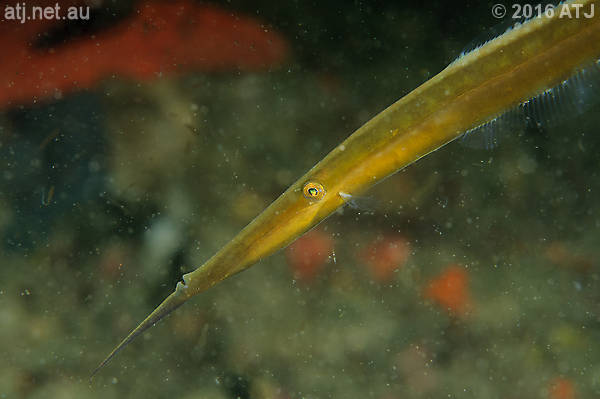
Bearded leatherjacket, Anacanthus barbatus, at The Leap.
On 12 February I was diving at The Leap and I spotted a nudibranch, Miamira magnifica, just before Seahorse Rock. We've seen these nudibranchs at Kurnell but none so close to The Leap. Most have been near The Steps. The next morning I was reviewing my photographs before heading back for another dive at The Leap when I noticed an emperor shrimp, Zenopontonia rex, on the nudibranch. I'd never seen one in the tropics, let alone in Sydney. I was determined to find it again. On 13 February after much searching I found the nudibranch and the shrimp was still there. I was then able to take some photographs of the shrimp itself. I saw it again on the 14th and 15th but later dives I could not locate the nudibranch.
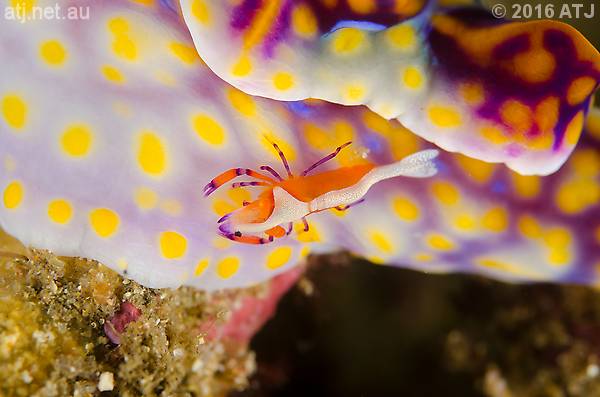
Emperor shrimp, Zenopontonia rex, on nudibranch, Miamira magnifica.
Another surprise new species was an egg cowrie, Volva volva, I was shown at Bare Island. It had been around for a few weeks before a dive buddy showed it to me and I never saw it again as it moved on.
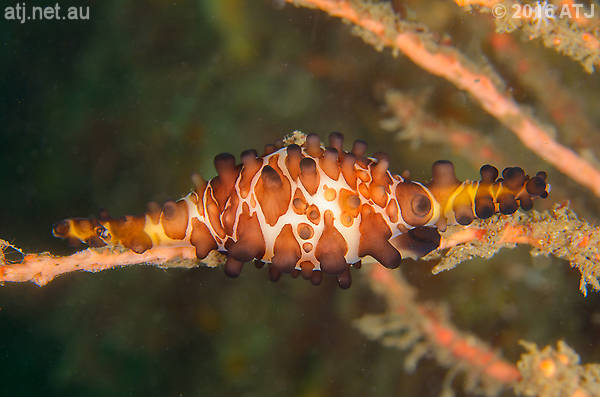
Egg cowrie, Volva volva, at Bare Island.
2016 was a great year for anglerfishes. In addition to the two freckled anglerfish at Clifton Gardens, there were a lot of juvenile painted anglerfish around in Sydney in 2016, as well as a number of red-fingered anglers and striped anglers.

The tiny painted anglerfish, Antennarius pictus, at Kurnell, with the tip of my reef probe for scale.
I saw some 7 different individual painted anglerfish, Antennarius pictus, at Kurnell, ranging from only a few millimetres to 30mm. One was the smallest I have ever seen. Not only were there orange ones, but there were two lemon coloured ones and even two black ones. At Bare Island I saw (or was shown) at least 5 painted anglers. They were all orange. There was a black one that I didn't get to see.

One of the lemon coloured painted anglerfish, Antennarius pictus, at Kurnell.
I saw a number of red-fingered anglerfish, Porophryne erythrodactylus, at both Bare Island and Kurnell, including a small orange one I saw at The Monument over a number of months. It was still there after the storm.
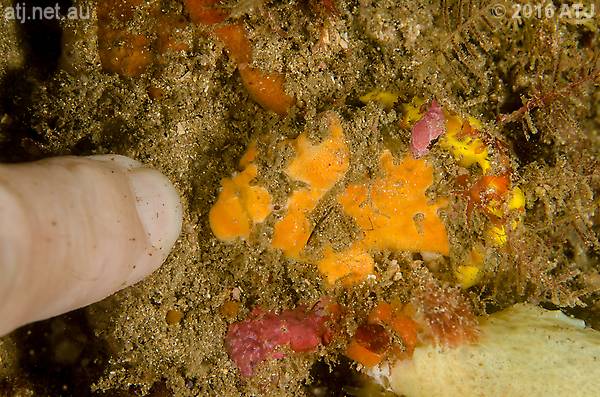
The small red-fingered anglerfish, Porophryne erythrodactylus, at Kurnell, with my finger for scale.
There were a few striped anglerfish, Antennarius striatus, around, too, at Bare Island and Clifton Gardens.

A striped anglerfish, Antennarius striatus, at Bare Island.
The year started brilliantly for Syngnathids. At The Leap at Kurnell I was seeing at least 5 and as many as 12 weedy seadragons, Phyllopteryx taeniolatus on each dive. There were 12 pot-bellied seahorses, Hippocampus abdominalis, I was seeing regularly at Kurnell, plus another couple I'd see occasionally. There were many pygmy pipehorses, Idiotropiscis lumnitzeri, at both Kurnell and Bare Island. There was even a bent stick pipefish, Trachyrhamphus bicoarctatus, I was seeing on the same rock each time I dived The Leap. Noel Conlon saw a thorny seahorse, Hippocampus histrix, at The Monument in February. We looked for it on subsequent dives but couldn't find it.
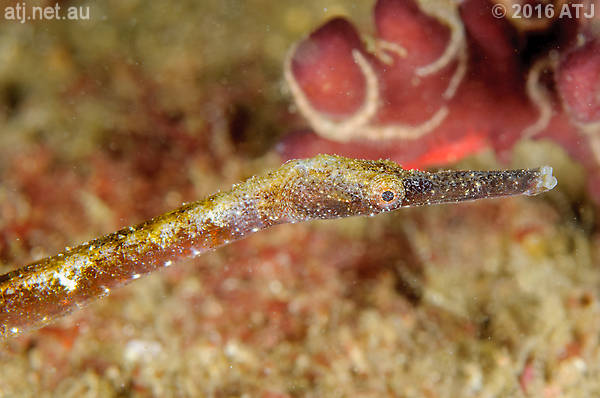
The bent stick pipefish, Trachyrhamphus bicoarctatus, I was seeing regularly at The Leap.
Then the storm came...
Since the storm, I have seen far fewer weedy seadragons at The Leap. Six was the most I saw in one dive and some dives I'd only see one. There are a number of individuals I have not seen since the storm.
I saw only three pot-bellied seahorses at Kurnell after the storm:
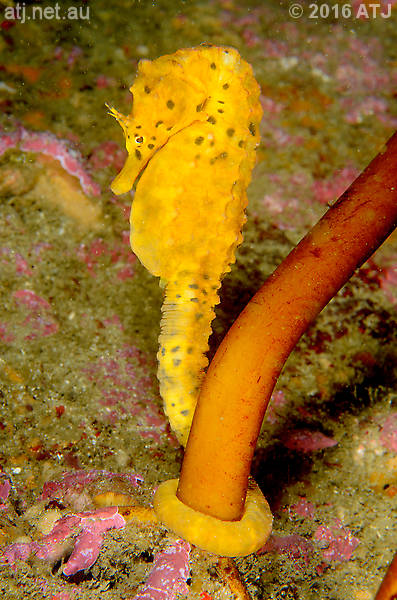
"Rosie", the pot-bellied seahorse, Hippocampus abdominalis, on 16 August, the only time I saw her after the storm.
The presence of the great seahorse, Hippocampus kelloggi goes some way to making up for the loss of the pot-bellied seahorses but I believe there are still some around and just have to find them.
I haven't seen the bent stick pipefish since the storm.
Interestingly, the storm had little impact on the pygmy pipehorses and I still see them regularly on dives at both Kurnell and Bare Island.
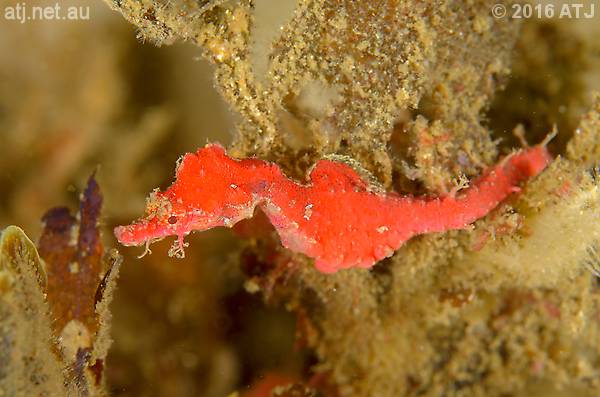
A male pygmy pipehorse, Idiotropiscis lumnitzeri, at The Monument in August, one of many I saw in 2016.
I had previously seen ghostpipefishes in the tropics and I had seen a pair of robust ghostpipefish at Camp Cove a few years ago but 2016 was the year of the ghostpipefishes in Sydney. Both robust and ornate ghostpipefishes have been seen around Sydney from time to time at least for as long as I have been diving (more than 30 years) but the number we saw in Sydney in 2016 was incredible.

The first ornate ghostpipefish, Solenostomus paradoxus, I saw at The Leap in February.
I stumbled on an ornate ghostpipefish, Solenostomus paradoxus, at The Leap on the 1st of February. Over the next few days and weeks reports were coming in from divers of both ornate and robust ghostpipefishes all around Sydney. I saw a robust ghostpipefish, Solenostomus cyanopterus, and a second ornate at The Steps on 13 February. The next day at The Leap I saw two more robust plus the robust and ornate I seen on the 13th. On the following day (15th) I saw another new robust ghostpipefish as well as those from the previous 2 days. That was 4 robust and 2 ornate ghostpipefishes in around 15 days. I saw the robust ghostpipefish at Kurnell a few times over the following 2 weeks and then they were gone.

The first robust ghostpipefish, Solenostomus cyanopterus, I saw at Kurnell in February.
There had been reports of a number of ornate ghostpipefish and Clifton Gardens and I finally got to see one of them at the end of March.
On 16 April I found another ornate ghostpipefish near Big Rock at Kurnell. It may have been one of the previously seen one but I suspect it was new. On subsequent dives I looked around Big Rock but could not find it again until 14 May when I spotted 2 ornate ghostpipefish together near Big Rock. I suspect one of them was the one I'd seen a month earlier. They were around until the end of May and then we didn't see them again - most likely due to the storm.
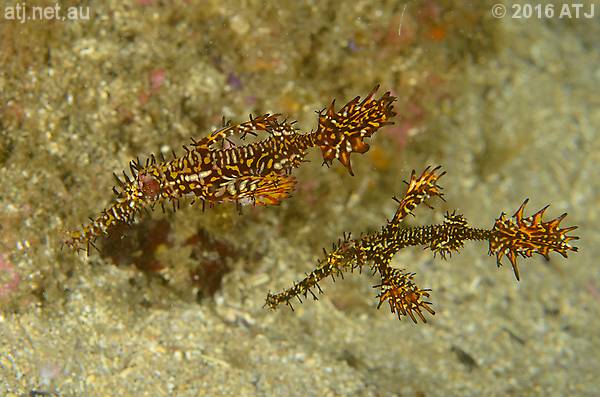
The pair of ornate ghostpipefish, Solenostomus paradoxus, at The Leap in May.
On 21st October while diving between The Steps and The Monument I spotted 2 separate robust ghostpipefish on the sand line. The following day I did a dive from The Leap to The Monument and spotted two juvenile ornate ghostpipefish: one in Seadragon Alley and one just past Diversity Rock. Then between The Steps and The Monument I spotted 4 robust ghostpipefish, the two from the previous day and another two. Two weeks later I saw a single robust ghostpipefish between The Steps and The Monument. I assume it was one of the 4 I'd seen previously.

One of the four robust ghostpipefish, Solenostomus cyanopterus, I saw at between The Steps and The Monument in October.
I didn't see any more ghostpipefish in 2016 but 6 ornate ghostpipefish and 8 robust in one year is pretty good.
2016 was an interesting year for nudibranchs. There were quite a few Miamira magnifica around with at least 3 near The Steps and one near The Leap. The one near The Leap had a commensal Shrimp. There were two hanging together for a few weeks near The Steps.
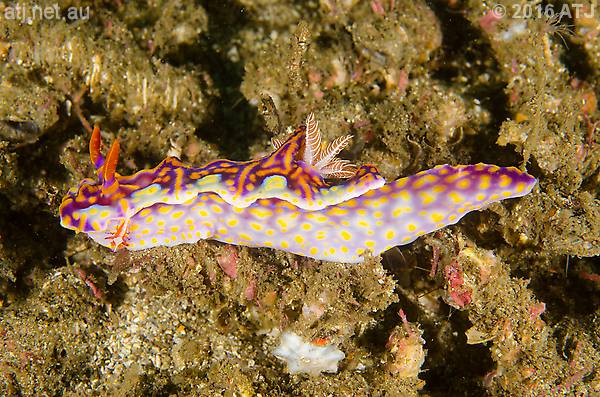
Nudibranch, Miamira magnifica, with commensal emperor shrimp, Zenopontonia rex, at The Leap in February.

Two nudibranchs, Miamira magnifica, near The Steps in February.
In February, Mike Scotland found a Ardeadoris rubroannulata near The Steps. I'd found one at Bare Island a year earlier but this was the first at Kurnell.
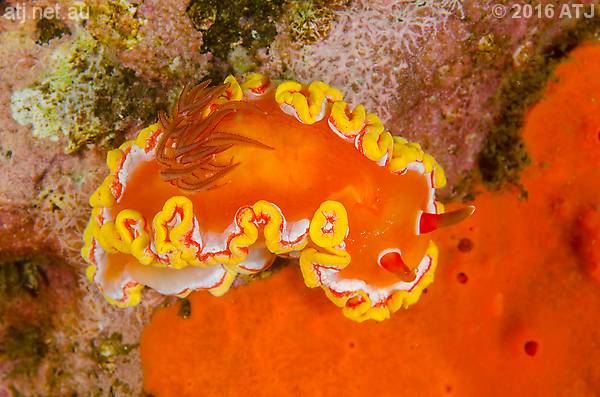
Nudibranch, Ardeadoris rubroannulata, near The Steps in February.
Nembrotha purpureolineata have become quite common now at Kurnell and it is rare that I don't see at least one per dive.
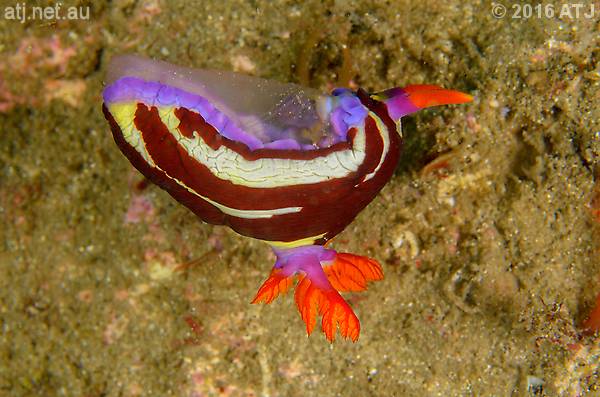
Nudibranch, Nembrotha purpureolineata, at Kurnell in December.
I saw a few Ceratosoma brevicaudatum throughout the year at Kurnell.
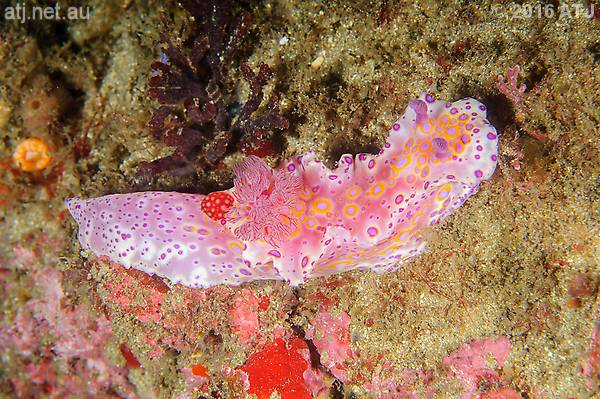
Nudibranch, Ceratosoma brevicaudatum, at Kurnell in May.
It is not easy to predict the future but I hope 2017 will be another fun year of diving. I doubt I will be able to beat the 174 dives I did in 2015 but I hope to dive often. I have two dive trips planned, one to Mexico in February and one to Bali in September. Both should be memorable trips. I also hope to find some pot-bellied seahorses at Kurnell in 2017, and I'd really love to find some of the ones I know.
I'm looking forward to an exciting 2017.
Last updated: 16 January 2017